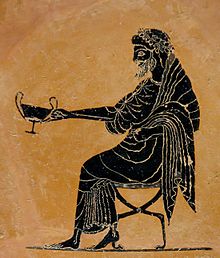Kantharos



A kantharos ( Greek κάνθαρος , plural Greek κάνθαροι Kantharoi ) is an ancient Greek, cup-like drinking vessel with two raised, vertical and wide loop handles that are mostly attached to the lip . The vessel is closely related to the cult of the god Dionysus , whose attribute the kantharos is also considered. It was later adopted and varied by the Etruscans and Romans .
The shape of the kantharos developed in the Middle Helladic period and was already considered an ancient vase shape in the classical period . The mold was initially made mainly in Laconia and Boeotia . It was a typical votive offering , but also a cult object in the private sphere. In Geometric times , kantharoi were often used as grave goods in Boeotia and Attica . They are mostly found in men's graves and are often decorated with warlike or athletic motifs from the field of funeral games . Since around 600 BC The typical form developed on a high foot. During this time, the Etruscans also took over the form, in addition to painted specimens, they mainly produced many pieces in Bucchero ceramic. In Boeotia it remained a popular burial object until the late classical period.
Since the late Classical and Hellenistic times, the form has also been found in profane use outside of the cultic. The reference to the male sphere remained until the end of the red-figure vase painting , as the pictures especially in Boeotia show. Even after the Kantharoi found more profane use, the reference to the cult of the dead remained in many cases. Specimens up to 50 centimeters in height were produced as grave attachments, and Kantharoi were also found as images on Boeotian grave steles and thus correspond to loutrophores and lekyths in Attic funerary art. In addition, the form often appears in Attic vase painting , here not infrequently in the hands of Dionysus or one of his companions. A special form were the so-called head kantharoi , which were designed as plastic vessels with the faces of mythological figures. The shape was produced up to Roman times, then also in other regions of the empire. In addition to the ceramic specimens, vessels made of metal and glass were also created.
The so-called Kabiren-Kantharoi are not Kantharoi, but Skyphoi .
Attic-geometric kantharos (around 780 BC): snakes on the handles mark the vessel as being dead. State Collections of Antiquities, Munich.
Etruscan head kantharos of the Chiusi group , 2nd half of the 4th century. Louvre.
Southern Italian kantharos of the Xenon genus , 4th century BC Chr., Private collection.
Romano-British silver cantharos from the Water Newton treasure . British Museum.
Samian -Kantharos from Rheinzabern with Barbotine -decor, late second century. British Museum.
literature
- Ingeborg Scheibler : Greek pottery art. Manufacture, trade and use of the antique clay pots (= Beck's archaeological library ). CH Beck, Munich 1983, ISBN 3-406-09544-5 , pp. 20-21, 38.
- Ingeborg Scheibler: Kantharos [1]. In: The New Pauly (DNP). Volume 6, Metzler, Stuttgart 1999, ISBN 3-476-01476-2 , Sp. 253.




